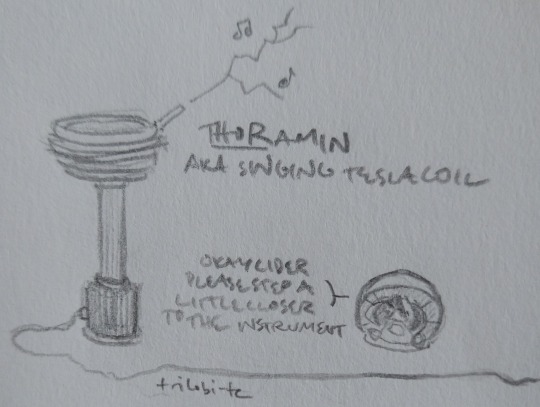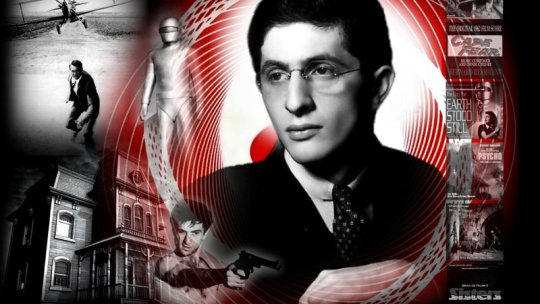#I really want to try to play a theremin one day but unfortunately they are like 400+ dollars
Explore tagged Tumblr posts
Text

Cider and a theremin! I headcanon that he's able to play it because he just seems like that type of person.. he has those vibes......
Plus some extra doodles


Chip/Theremin rambling and doodle transcriptions below the cut. I included some explanations for the instruments pictured because I'm worried the drawings would otherwise be incomprehensible lmao
In case you can't read my handwriting: Doodle 1: Cider is saying "DANDY NO" and underneath it says *horrible theremin screaming* Doodle 2: the title says THORamin aka singing Tesla coil, and Otto is saying "Okay Cider please step a little closer to the instrument"
I like weird instruments so I assign them to fictional characters whenever it feels realistic to do so. The theremin is one of the world's first electric instruments (patented in 1928) and is played by moving one's hands around the two antennas, which are proximity sensors - vertical controls pitch and horizontal controls volume. Sound-wise, it's kind of like playing a synthesizer by hand? Also the hand gestures that are made when controlling pitch are.. interesting. (That's more or less what Cider is doing, it took an embarrassing amount of attempts to get that hand to look good enough so I just left it hhh)
Re: extra doodle 1 Touching the vertical antenna makes an unpleasant high-pitched noise (you're not meant to touch it at all while playing, just move your hands around like an electric wizard or something)
Re: extra doodle 2 "Thoramin" is another name for the singing Tesla coil, and a play on theremin and Thor (hence why it's here). It's a Tesla coil that's been modified to be a plasma speaker. I find these funny because people on YouTube always seem to be playing them in random suburbs. Just imagine looking out the window at your neighbor's yard and seeing a lightning storm set to Megalovania. Realistically Otto probably wouldn't have one (too loud, draws attention to the player) but for the purposes of The Funny™ he does now.
Something small I don't have anywhere else to bring up so I shall talk about it here: I started my Chipspeech Twitter archive project by just going through the tab on each account that says "Tweets" but it turns out that there are more tweets under the "Replies" tab that actually contain lore. So I am actually nowhere near done with this hhhhh I hate Twitter. I mean I'm still going to document everything because I want the story to be as intact as possible (including the small bits of character trivia that often show up in the replies tweets) but I am. not happy about it. I do not entirely understand the decision to put character information in the replies to fan tweets.. I mean things shared there are never really all that important, but I like weird small story details so I don't want to lose them if Twitter ever actually fully goes down. Also I am going to have to go back and put everything in chronological order (in terms of hours/minutes, everything currently is just organized by date) which means more time on Twitter. I traded efficiency for simplicity of each step in this process, which I guess was good for not becoming overwhelmed by the scale of things but it's dragging out a lot longer than I had initially anticipated. I start college in late August so ideally that's my hard deadline for this, which should absolutely be reachable but I'm still annoyed that it's taking this long in the first place hhhhhhh
#I am directing my autism energy towards the characters I like hehehehehe#I really want to try to play a theremin one day but unfortunately they are like 400+ dollars#afaik the only other way to get one is to rent it or borrow it from a library and all of the libraries in my area are small#there's no way they'd have a theremin.. sad bug hours#also I actually colored/shaded this time.. with office supplies because thin paper and also I like office supplies :)#chipspeech#cidertalk'84#cidertalk84#dandy 704#otto mozer#theremin#posts by the bug
9 notes
·
View notes
Text
The works of Bernard Hermann

In this blog, I have tried to celebrate the great directors, composers, and cinematographers of film along with the movies that they produce. I am sad to say, however, that I have spent over 3 years on this film journey and have barely mentioned the works of my favorite film score composer. I love the work of John Williams for his uplifting scores that make an audience want to cheer and I love the popular culture masterpieces created by Rogers and Hammerstein plays, but nothing competes with the psychological encapsulation of a character like the works of Bernard Hermann. I want to go through some of the movies he has scored and I feel you will be surprised how many stand out pieces he created that are part of the American zeitgeist:
Citizen Kane (1941)
Starting of strong! The first movie that Hermann scored is considered by many to be the best American film of all time. He unfortunately did not win the Oscar for this work...because he lost to himself. He won his only Best Musical Score Academy Award for the film The Devil and Daniel Webster.
The Day the Earth Stood Still (1951)
Taking advantage of both the theremin and the glockenspiel, Hermann created the first electronic sound score in Hollywood. It has a sound that defined the outer space monster movies of the 50s. Here's a little sample of the famous opening. Think of all of the movies and TV shows and video games that are set in space that have a similar sound:
https://www.youtube.com/watch?v=rYbHpXca7U0
The Man Who Knew Too Much (1956)
I like this soundtrack because it exemplifies a love for good music without needing to put your own stamp on something that is already great. This was a remake of the 1934 film and Hermann decided to leave the original cantata that marked the film's climax as well as use the "Que Sera, Sera" song that the film was known for. Hermann was given the option to conduct his own climax score, but he recognized that it was better as it was and simply extended the length of the song to fit the Hitchcock remake.
Vertigo (1958)
Those who don't think that Citizen Kane is the best American movie generally think that this film is the best. One of the reasons that this film is so good is the score. Bernard Hermann liked to use harsh string sounds that were circular in nature to give a feeling of obsessive thoughts of a character. This is emphasized by deep brass intrusions that emphasize reality crashing in. It is truly capturing the sound of anxiety, and Hermann was able to do it effectively, over and over again. In fact, Martin Scorsese noted this as the first time he had heard a film score that truly captured the feeling of obsession. As a youth, Scorsese said he wanted to some day create a character that would fit this kind of score. Here is a sample of the theme that really exemplifies the film:
https://www.youtube.com/watch?v=kC5AzFc3coo
The 7th Voyage of Sinbad (1958)
I really like this film score because of how it fits with the Ray Harryhausen created monsters. It is so different from the internal struggles that Hermann captured for Hitchcock and instead accompanied the very outward struggle between man and mythical beast. It really captures the toil and desperation that a human would have facing off with a mythical creature. The vast range of instruments used to capture the essence of every monster is phenomenal. My favorite is the use of the xylophone during the duel with an animated skeleton:
https://www.youtube.com/watch?v=G5cLIrGuoVY
Psycho (1960)
One of the best known film scores of all time, this film owes a large part of the success to the score. The famous shower scene was supposed to be silent, but Bernard Hermann convinced Alfred Hitchcock otherwise and added that famous violin sting that mimicked the stabbing motion. There are few people in the world that can even compare with Hermann's ability to capture mental turmoil. A perfect match with Hitchcock's style, it is no wonder that Hermann scored a total of eight of Hitchcock's films.
Twisted Nerve (1968)
You might not know this movie or the soundtrack, but if you have ever seen Kill Bill Vol. 1, then you probably remember that horrific whistling of the one-eyed nurse sent to kill the bride. It is not the whistling per say, but the music that it is played over it that is so unnerving. It is dissonance on purpose and this might be the most effective use of it in a film that I know of. It is the embodiment of a dream turning into a nightmare and it is amazing:
https://www.youtube.com/watch?v=c1NN9rnNpEQ
Taxi Driver (1976)
This was the last work of Bernard Hermann and a dream come true for Martin Scorsese. The director and composer worked together to make that obsessive sound that worked so well for Alfred Hitchcock. With the combination, they successfully brought Travis Bickle to life and made him fully psychotic. That is one hell of a final work.
---------------------------------------------------------------------------
There are other works by Hermann not mentioned here that are fantastic, but trying to include everything would be an incredibly long post (the guy was a really prolific writer). I highly suggest checking out YouTube and searching Bernard Hermann scores. There is a lot of content and I am pretty sure you will find something great to add to your music list.
#film scores#psychology#obsession#bernard hermann#alfred hitchcock#martin scorsese#twisted nerve#psycho#introverts#introvert#great films#great music
14 notes
·
View notes